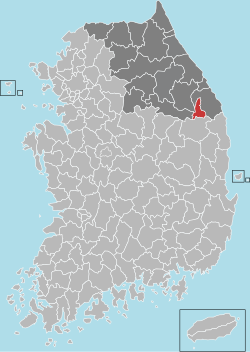Taebaek
Taebaek
태백시 | |
|---|---|
Municipal City | |
| Korean transcription(s) | |
| • Hangul | 태백시 |
| • Hanja | 太白市 |
| • Revised Romanization | Taebaek-si |
| • McCune-Reischauer | T'aebaek-si |
 | |
 Flag | |
 Location in South Korea | |
| Coordinates: 37°10′N 128°59′E / 37.167°N 128.983°ECoordinates: 37°10′N 128°59′E / 37.167°N 128.983°E | |
| Country | |
| Region | Gwandong |
| Administrative divisions | 8 dong |
| Area | |
| • Total | 303.53 km2 (117.19 sq mi) |
| Population (2015) | |
| • Total | 46,715 |
| • Density | 185/km2 (480/sq mi) |
| • Dialect | Gangwon |
| Climate | Dwb |
Taebaek (Korean pronunciation: [tʰɛ̝.bɛ̝k̚]) is a city in Gangwon province, South Korea. Its name is shared with that of the Taebaek Mountains. Situated at an altitude of 650 to 700 m (2,130 to 2,300 ft), Taebaek is the highest city in South Korea.
Attractions[]
Manggyeongsa Temple in Hyeol-dong, at an altitude of 1,460 meters on the Taebaek Mountains, is a temple built to enshrine the statue of the Bodhisattva of wisdom. It was built by Jajang, a Silla Dynasty monk. The "Dragon Spring" at the entrance of the temple is known as the highest spring in Korea.[1]
Climate[]
| Climate data for Taebaek (1981–2010, extremes 1985–present) | |||||||||||||
|---|---|---|---|---|---|---|---|---|---|---|---|---|---|
| Month | Jan | Feb | Mar | Apr | May | Jun | Jul | Aug | Sep | Oct | Nov | Dec | Year |
| Record high °C (°F) | 12.1 (53.8) |
20.1 (68.2) |
21.6 (70.9) |
29.7 (85.5) |
32.6 (90.7) |
35.0 (95.0) |
34.2 (93.6) |
35.6 (96.1) |
31.8 (89.2) |
26.4 (79.5) |
22.6 (72.7) |
15.2 (59.4) |
35.6 (96.1) |
| Average high °C (°F) | 0.5 (32.9) |
2.8 (37.0) |
7.2 (45.0) |
15.0 (59.0) |
20.1 (68.2) |
23.4 (74.1) |
25.3 (77.5) |
25.5 (77.9) |
21.2 (70.2) |
16.6 (61.9) |
9.7 (49.5) |
3.4 (38.1) |
14.2 (57.6) |
| Daily mean °C (°F) | −4.8 (23.4) |
−2.8 (27.0) |
1.9 (35.4) |
8.9 (48.0) |
14.0 (57.2) |
17.8 (64.0) |
20.9 (69.6) |
21.0 (69.8) |
16.0 (60.8) |
10.3 (50.5) |
3.9 (39.0) |
−2.0 (28.4) |
8.7 (47.7) |
| Average low °C (°F) | −9.7 (14.5) |
−8.0 (17.6) |
−3.2 (26.2) |
2.8 (37.0) |
8.0 (46.4) |
12.5 (54.5) |
17.2 (63.0) |
17.3 (63.1) |
11.4 (52.5) |
4.7 (40.5) |
−1.2 (29.8) |
−6.8 (19.8) |
3.8 (38.8) |
| Record low °C (°F) | −21.7 (−7.1) |
−20.3 (−4.5) |
−16.8 (1.8) |
−8.2 (17.2) |
−2.1 (28.2) |
0.5 (32.9) |
5.6 (42.1) |
8.3 (46.9) |
1.0 (33.8) |
−7.1 (19.2) |
−15.2 (4.6) |
−18.5 (−1.3) |
−21.7 (−7.1) |
| Average precipitation mm (inches) | 32.6 (1.28) |
35.8 (1.41) |
60.7 (2.39) |
77.4 (3.05) |
90.4 (3.56) |
142.2 (5.60) |
287.3 (11.31) |
279.6 (11.01) |
203.9 (8.03) |
51.8 (2.04) |
43.4 (1.71) |
19.2 (0.76) |
1,324.3 (52.14) |
| Average precipitation days (≥ 0.1 mm) | 8.3 | 7.7 | 10.5 | 8.6 | 9.4 | 11.2 | 16.5 | 15.6 | 11.5 | 6.8 | 7.6 | 6.4 | 120.1 |
| Average snowy days | 10.7 | 9.7 | 9.9 | 2.1 | 0.0 | 0.0 | 0.0 | 0.0 | 0.0 | 0.5 | 3.3 | 7.6 | 44.0 |
| Average relative humidity (%) | 61.3 | 60.6 | 61.8 | 55.3 | 61.3 | 71.8 | 78.6 | 79.8 | 78.8 | 70.3 | 64.1 | 60.5 | 67.0 |
| Mean monthly sunshine hours | 173.4 | 174.5 | 194.8 | 219.8 | 229.2 | 193.6 | 141.0 | 144.6 | 149.8 | 188.1 | 166.7 | 169.5 | 2,144.6 |
| Percent possible sunshine | 56.3 | 57.1 | 52.6 | 55.7 | 52.2 | 44.0 | 31.5 | 34.4 | 40.2 | 53.9 | 54.4 | 56.6 | 48.2 |
| Source: Korea Meteorological Administration[2][3][4] (percent sunshine and snowy days)[5] | |||||||||||||
Sister cities[]
This section does not cite any sources. (July 2018) |
 Helong, Jilin, China since August 29, 1995
Helong, Jilin, China since August 29, 1995 Baguio, Philippines since April 25, 2006
Baguio, Philippines since April 25, 2006 Suzhou, Jiangsu, China since March 8, 2005
Suzhou, Jiangsu, China since March 8, 2005 Gao'an, Jiangxi, China since June 23, 2004
Gao'an, Jiangxi, China since June 23, 2004 Changchun, Jilin, China since January 18, 2006
Changchun, Jilin, China since January 18, 2006
See also[]
References[]
- ^ Cin Woo Lee "Simply stunning: 33 incredible Korean temples" Archived 2012-04-17 at the Wayback Machine CNN Go. 10 February 2012. Retrieved 2012-04-12
- ^ 평년값자료(1981–2010) 태백(216) (in Korean). Korea Meteorological Administration. Retrieved 2011-05-01.
- ^ 기후자료 극값(최대값) 전체년도 일최고기온 (℃) 최고순위, 태백(216) (in Korean). Korea Meteorological Administration. Retrieved 10 February 2017.
- ^ 기후자료 극값(최대값) 전체년도 일최저기온 (℃) 최고순위, 태백(216) (in Korean). Korea Meteorological Administration. Retrieved 10 February 2017.
- ^ "Climatological Normals of Korea" (PDF). Korea Meteorological Administration. 2011. p. 499 and 649. Archived from the original (PDF) on 7 December 2016. Retrieved 10 February 2017.
External links[]
Categories:
- Taebaek
- Cities in Gangwon Province, South Korea
